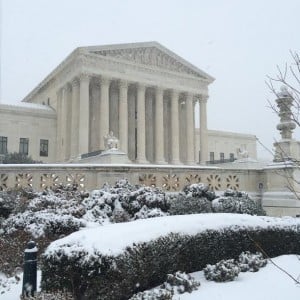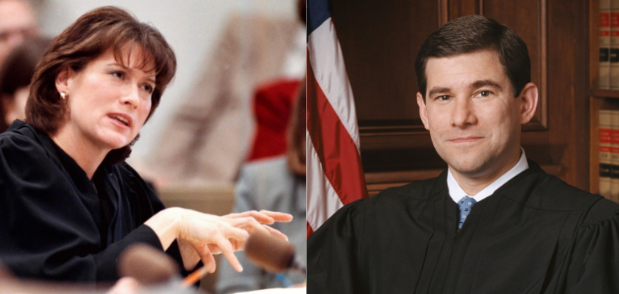Handicapping Donald Trump's Supreme Court Shortlist
It looks like it's down to two: Judge Diane Sykes and Judge Bill Pryor.

Winter is coming (or technically here); is a SCOTUS nomination as well?
More than a month has passed since President-elect Donald Trump told us to expect a Supreme Court nomination “pretty soon.” But even if a SCOTUS nominee to replace the late Justice Antonin Scalia gets announced forthwith, it’s unlikely that this new justice will join the Court in time to participate in any decisions for the current Term.[1]
So that’s the “when” of this story. What about the “who”? In case you missed it over the holidays, Jan Crawford of CBS News, one of the most plugged-in Supreme Court reporters around, revealed Trump’s five finalists (in alphabetical order, and with thanks to How Appealing; full transcript of the discussion here):

Is The Future Of Law Distributed? Lessons From The Tech Adoption Curve
- Judge Steven Colloton (8th Cir.) of Iowa
- Judge Thomas Hardiman (3d Cir.) of Pennsylvania
- Justice Joan Larsen of Michigan
- Judge William Pryor (11th Cir.) of Alabama
- Judge Diane Sykes (7th Cir.) of Wisconsin
These five judges all appeared on Trump’s first SCOTUS list of 11 names, suggesting that his supplemental list of 10 names might represent something of a second tier. But the legal and journalism professions must thank the Donald for his not-so-short “shortlist” of 21. It made the SCOTUS process closer to a reality TV show, with more than a dozen competitors to start, and more fun than a traditional presidential process with maybe four to six contenders.
UPDATE (7:05 p.m.): According to Shane Goldmacher and Josh Gerstein of Politico, still in the mix are Judge Raymond Kethledge (6th Cir.), Judge Raymond Gruender (8th Cir.), and Judge Neil Gorsuch (10th Cir.). Judge Kethledge and Judge Gruender appeared on Trump’s first list, while Judge Gorsuch was on the second list.
Of the finalists, who has the edge? My money is on Judge Pryor and Judge Sykes, for a few reasons:
Sponsored

Early Adopters Of Legal AI Gaining Competitive Edge In Marketplace

Legal AI: 3 Steps Law Firms Should Take Now

Is The Future Of Law Distributed? Lessons From The Tech Adoption Curve

Navigating Financial Success by Avoiding Common Pitfalls and Maximizing Firm Performance
1. They’ve been on Trump’s radar screen for a long time. During the Republican presidential debate that took place right after Justice Scalia’s passing, Trump called them out by name: “We could have a Diane Sykes or a Bill Pryor.”
2. The buzz is on their side. When I attended the National Lawyers Convention of the Federalist Society back in November, where numerous Republican power brokers (and many Trump shortlisters) made appearances, the SCOTUS talk centered on Pryor and Sykes, and continued to focus on them into December.
3. Prediction markets favor them. See, e.g., PredictIt and FantasyJustice by Josh Blackman.
(Yes, the top vote getter on FantasyJustice right now is Judge Neil Gorsuch (10th Cir.). But if you look at just the five finalists identified by Jan Crawford and eliminate the others, you’ll see that Pryor and Sykes are far ahead of Colloton, Hardiman, and Larsen. Also, as I know from having attended the Fed Soc conference in November, where Blackman was taking in-person predictions from attendees, some judges could — and did — strongly encourage their clerks, colleagues, and friends to make supportive predictions.)
4. They are both solidly conservative. They are conservative in terms of the outcomes they reach, writing opinions and casting votes striking down various Obamacare provisions and upholding voter ID laws. They are conservative in terms of methodology, emphasizing Justice Scalia’s themes of textualism, originalism, and judicial restraint. Not surprisingly, they are active in the Federalist Society, aka the legal profession’s vast right-wing conspiracy.
Sponsored

Navigating Financial Success by Avoiding Common Pitfalls and Maximizing Firm Performance

The Business Case For AI At Your Law Firm

UPDATE (10:42 p.m.): According to this study, Sykes and Pryor are in the Alito-Thomas range of conservatism (with Sykes a little more conservative than Pryor).
UPDATE (1/7/2017, 9:45.m.): But this study is very much open to question (as Orin Kerr notes).
5. They are highly qualified and super-smart, yet not “elites” — a very “Trumpy” combination.
Pyror and Sykes have long and distinguished records of judicial service, and they are highly regarded as jurists. Even their ideological adversaries concede their brilliance. See, e.g., Ian Millhiser, author of Injustices: The Supreme Court’s History of Comforting the Comfortable and Afflicting the Afflicted (affiliate link): “Trump’s potential justices are really smart and really awful. Really. Awful.”
But they are not coastal elites: Pryor is from Alabama, and Sykes is from Wisconsin. They went to strong but not Ivy League or “T14” law schools: Tulane for Pryor, and Marquette for Sykes. They have not spent their entire careers in the federal system: Pryor served as Alabama’s attorney general before taking the bench, and Sykes was a state trial and appellate judge before joining the Seventh Circuit.
(Contrast them in this regard to Colloton (Yale, Office of Legal Counsel, federal prosecutor); Hardiman (Georgetown Law, Skadden Arps); and Larsen (Northwestern Law, Office of Legal Counsel). If Trump wants to “drain the legal swamp,” expect him to steer clear of the T14/Biglaw/Main Justice types, going instead with nominees from the “real America.”)
6. They have powerful backers. Pryor is pals with incoming attorney general Jeff Sessions, his fellow Alabaman, and Sykes gets support from incoming White House chief of staff Reince Priebus, her fellow Wisconsinite. This type of stuff might sound silly, but in D.C. circles, connections matter. (For example, there are many lawyers across the country qualified to serve as U.S. solicitor general, but the ones getting buzz — George Conway, Chuck Cooper, Noel Francisco, and Greg Katsas — all have strong ties to the Trump White House or Justice Department.)
(One other random fact: Sykes was once married to conservative Wisconsin talk show host Charlie Sykes, a leader of the #NeverTrump faction during the presidential campaign. But she is his ex-wife, and they divorced back in 1999, almost two decades ago. This connection should not be an issue.)

Judge Diane Sykes and Judge William Pryor
As between Pryor and Sykes, who has the stronger shot? I’m going with Sykes. (Disclosure: I have had the honor of meeting both judges and I admire them both greatly, but I know Judge Sykes better, having participated in events with her at the University of Chicago and Marquette Law Schools.)
Here are the relevant factors:
1. Age. Members of Team Pryor point out that he is younger than Sykes (54 to her 59). This is a problem for Sykes — presidents, especially Republican presidents, like their justices young — but not an insurmountable one. Justice Ginsburg was 60 when appointed to SCOTUS, and Justices Breyer, Alito, and Sotomayor were all over 55 when they joined the Court. Also, recall that women live longer than men; as noted by Josh Blackman, based on actuarial analysis, Judge Pryor and Judge Sykes have the exact same life expectancy.
Interestingly enough, Judge Sykes’s age could actually help her, at least in terms of getting the first Trump appointment. On inauguration day, Justice Ginsburg will be 83, Justice Kennedy will be 80, and Justice Breyer will be 78. While we wish all three of them long tenures on the Court, it is possible, even likely, that President Trump will get one or more SCOTUS appointments in addition to the one he currently has. So if he thinks Judge Sykes is a strong candidate (which she is), he would be well advised to appoint her now, to give her the longest possible tenure on SCOTUS.
The remaining four finalists — Colloton (53), Hardiman (51), Larsen (48), and Pryor (54) — are all young enough to be considered for future vacancies. But Judge Sykes this December will turn 60, which is traditionally viewed as the age cutoff for appointing a justice. So with the long game in mind, Trump should select Sykes.
2. Confirmability. Judge Pryor is a nominee in the mold of a Judge Edith Jones (5th Cir.) or a Judge Emilio Garza (5th Cir.). The full-throated expression of conservative views that Republicans love about him is also what would make him harder to confirm.
A recent interesting paper, Searching for Justice Scalia: Measuring the “Scalia-Ness” of the Next Potential Member of the U.S. Supreme Court, gave Pryor high marks for “Scalia-ness.” But when it comes to confirmation, “Scalia-ness” isn’t necessarily a plus.
Take abortion. It’s de rigueur for senators to ask SCOTUS nominees in their hearings for their views on Roe v. Wade (and Senator Chuck Schumer has already highlighted protecting Roe as a priority). It’s then de rigueur for the nominee to say (1) Roe is precedent (duh); (2) I respect precedent (of course you do); (3) yes, precedent can be overruled (with a digression here on stare decisis and the circumstances under which a case can be overruled); and (4) sorry, can’t say more because abortion might come before the Court, toodles!
It’s a time-honored song and dance, but one that Judge Pryor would have a hard time performing. He previously stated, as groups like NARAL love to tout, that Roe was the “worst abomination in the history of constitutional law,” amounting to “a constitutional right to murder an unborn child.”
Statements like these, plus additional concerns raised by African-American and LGBT groups about other aspects of Bill Pryor’s record, led Democrats to filibuster his Eleventh Circuit nomination. President George W. Bush had to resort to a recess appointment to place Pryor on the Eleventh Circuit, and his final confirmation vote was close: 53-45. Judge Sykes won confirmation by a much more comfortable margin, 70-27.
3. Diversity. To be sure, President-elect Trump isn’t big on diversity, as reflected in his appointments thus far. As we observed when he passed over Gibson Dunn partner Debra Wong Yang in favor of Sullivan & Cromwell partner Jay Clayton for SEC head, “even when choosing between two elites, President-elect Trump goes for the white male.”
But if he’s torn in the end between Pryor and Sykes, Sykes’s gender might be a tie-breaker, since it helps in terms of both confirmability and improving the GOP’s standing with women. Per Tim Alberta in the National Review, “Sykes is considered to be every bit as conservative as Pyror, but is less controversial…. She also is — quite obviously — a woman, and Republicans have been eager for decades to appoint a female Supreme Court justice. (The Harriet Miers fiasco still haunts many GOP establishment types.) Allies of Sykes say it would prove especially difficult for Democrats to oppose her: She’s a 58-year-old single mother who hails from the heartland.”
4. Attractiveness. Some might find it stupid, distasteful, or even offensive of me to raise physical attractiveness in the context of comparing two Supreme Court contenders; presidents generally select justices for their minds, not their bodies. But Donald Trump is not your ordinary president. And as we know from his catty comments about people’s looks while on the campaign trail, as well as his willingness to consider Mitt Romney for secretary of state because he “looked the part,” the Donald places a priority on appearance.
(I’m not at liberty to divulge details, but I have a friend who, some time ago, was offered a job with Trump basically because he met her casually and found her attractive (and told her as much). He eventually got to know her better and learned of her brilliance and accomplishments, but it was clear in my friend’s retelling of this tale that he wouldn’t have taken the initial interest in her had he not found her compelling in terms of her appearance.)
What does this mean for Judge Sykes and Judge Pryor? If you’ve seen them in person, you know that they are both rather attractive (especially by the standards of the federal judiciary). Judge Pryor looks like he could be a male model, and he keeps in shape by running. As for Judge Sykes, in 2004 she was named a Superhottie of the Federal Judiciary, described in her nomination blurb as “startlingly pretty and elegant,” with a “cool,” “businesslike,” “yuppie sort of appeal.”
So both Judge Sykes and Judge Pryor would pass Donald Trump’s “look the part” test. But as we know all too well, Donald Trump is a red-blooded, heterosexual American male. If he interviews both potential nominees in person, as presidents traditionally do, I suspect he will find Judge Sykes more appealing.
(Again, my apologies to anyone who is offended by such frivolity while discussing a life-tenured position on the highest court in the land. But I’m sorry, this is the world that Donald Trump has made, and I’m trying to be a realist. Here at Above the Law, we call things as we see them, even at the risk of occasionally causing offense.)
In sum, I’m predicting that Judge Diane Sykes will be President Donald Trump’s first Supreme Court nominee. And I’m not alone in this prediction. For example, Jeffrey Toobin also expects a Justice Sykes in 2017, noting that aside from her age, “she’s everything else they want in a Justice.”
Is it exciting to predict Justice Sykes? Not really. She’s one of the odds-on favorites at this point in time.
But you know what makes this process fun? How often the pundits’ predictions are wrong. When President Barack Obama was looking to nominate someone to fill the seat of the late Justice Antonin Scalia, I was pretty certain that he would go with either Judge Sri Srinivasan (D.C. Cir.) or Judge Paul Watford (9th Cir.), and most other observers agreed. But then POTUS surprised everyone and nominated Chief Judge Merrick Garland (D.C. Cir.) to SCOTUS (which was, in hindsight, a brilliant move; Judge Garland was thrilled to tears by the nomination, while Judges Srinivasan and Watford were kept in “pristine” condition — unsullied by politics, and ready for elevation under President Elizabeth Warren).
And then, of course, we have an even bigger blooper by the chattering class: our collective failure to foresee the election of Donald Trump as our 45th president. So consider this a lesson learned: as long as the Donald is involved, accurate prediction is impossible.
P.S. But please, dear Lord, let Trump at least stick to his slate of 21 names. We do not need Peter Thiel on the Supreme Court.
[1] No new justice before the end of this Term — at least that’s what experts like former solicitor general Ted Olson and veteran SCOTUS correspondent Jeffrey Toobin believe (and I don’t disagree with them). Another former SG, Don Verrilli, believes that it’s “possible” we might get a justice on the Court in time for the April sitting, but that would be “optimistic.”
If you look at the last few nominations, it has generally taken about three months to go from nomination to confirmation — Elena Kagan (announced 5/10/2010, confirmed 8/5/2010), Sonia Sotomayor (announced 5/26/2009, confirmed 8/6/2009, Samuel Alito (announced 10/31/2005, confirmed 1/31/2006). And those nominations didn’t come at the start of a president’s new term, when the Senate will be busy holding hearings for many other appointees, including Cabinet officials, and addressing other priorities (e.g., Obamacare, or the termination thereof).
Face the Nation Transcript: December 25, 2016 [CBS News via Morning Docket]
Inside Trump’s strategy to remodel the Supreme Court [Politico]
GOP Consensus on Trump SCOTUS Pick: Sykes or Pryor [National Review]
Sykes, Pryor among top contenders for Supreme Court vacancy [CNN]
FantasyJustice [FantasySCOTUS / LexPredict]
Trump’s Supreme Court Shortlist Is Making The Rounds [Daily Caller]
Earlier: Trump To Make SCOTUS Great Again ‘Pretty Soon’
Making SCOTUS Great Again: Trump’s Supreme Court Shortlist
Making SCOTUS Even Greater: Trump’s Supplemental Supreme Court Shortlist
 David Lat is the founder and managing editor of Above the Law and the author of Supreme Ambitions: A Novel. He previously worked as a federal prosecutor in Newark, New Jersey; a litigation associate at Wachtell, Lipton, Rosen & Katz; and a law clerk to Judge Diarmuid F. O’Scannlain of the U.S. Court of Appeals for the Ninth Circuit. You can connect with David on Twitter (@DavidLat), LinkedIn, and Facebook, and you can reach him by email at dlat@abovethelaw.com.
David Lat is the founder and managing editor of Above the Law and the author of Supreme Ambitions: A Novel. He previously worked as a federal prosecutor in Newark, New Jersey; a litigation associate at Wachtell, Lipton, Rosen & Katz; and a law clerk to Judge Diarmuid F. O’Scannlain of the U.S. Court of Appeals for the Ninth Circuit. You can connect with David on Twitter (@DavidLat), LinkedIn, and Facebook, and you can reach him by email at dlat@abovethelaw.com.







